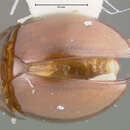pms
nòm ant ël fil


Gelae (/ˈdʒɛli/) is a genus of round fungus beetles belonging to the family Leiodidae.[2] The beetles are found in different parts of Central and North America. They are small and rounded, feeding on slime moulds. They were originally placed in the genus Agathidium following the discovery of the first species, G. cognatum, in 1878.[3] The taxonomic position was revised with description of new species in 2004 by American entomologists Kelly B. Miller and Quentin D. Wheeler. Upon creation of the new genus, the five new species are Gelae baen (sounding like "jelly bean"), G. belae ("jelly belly"), G. donut ("jelly doughnut"), G. fish ("jelly fish"), and G. rol ("jelly roll").[1][4]
The first species of Gelae discovered was Agathidium cognatum (now Gelae cognatum). John Lawrence LeConte discovered the only specimen at Marquette, Michigan, near Lake Superior, in 1878.[3] Another specimen was found by Andrew Matthews in 1887 from the mountains of Totonicapán in Guatemala, and placed it under the then known genus Agathidium. Henry Clinton Fall collected the third species in 1934 from Sugar Pine, California, US.[5] In 1998, Stewart Blaine Peck, Pedro Gnaspini and Alfred F. Newton Jr. reported the occurrence of closely related but distinct species from their extensive cataloguing of round fungus beetles. They noted that the species had unique features different from Agathidium and other beetles, and labelled them under "Undescribed Genus 7".[6] With reexamination of the tribe Agathidiini to which they belong, they were reclassified under a new genus Gelae in 2004. Kelly B. Miller and Quentin D. Wheeler described their significant characters and regrouped them, along with five new species, G. baen, G. belae, G. donut, G. fish, and G. rol.[7] They derived the name from a Latin word gelatus, which means "congealed" or "jellied", and to be pronounced like the English word "jelly". This refers to the slime moulds in which they were found. The species names are merely wordplays without any taxonomical jargon, and are simply "whimsical arrangement of letters", as the authors noted.[1]
Species of Gelae are small and almost spherical beetles, with highly curved and dome-shaped backs. As with other agathidiines, their food source is slime moulds. According to a cladogram published in 2014, they are most closely related to Liodopria under the same tribe, and are considered as sister taxa.[8] In contrast to other round fungus beetle, Gelae have exactly 11 antenna segments (antennomeres), the antennomere VII being similar in size and shape to antennomere VI, and an antenna club with three segments. An extension behind the eye called postocular temporum and its surrounding ridge called supraocular carina, found in other beetles, are absent. The middle front head region called the anterior clypeus is also comparatively extended. In addition the elytra (forewings) are moderately lined with punctures, and do not form longitudinal series.[1]
As of 2014, there are eight valid species of Gelae, as below:[1]
{{cite book}}: External link in |postscript=Gelae (/ˈdʒɛli/) is a genus of round fungus beetles belonging to the family Leiodidae. The beetles are found in different parts of Central and North America. They are small and rounded, feeding on slime moulds. They were originally placed in the genus Agathidium following the discovery of the first species, G. cognatum, in 1878. The taxonomic position was revised with description of new species in 2004 by American entomologists Kelly B. Miller and Quentin D. Wheeler. Upon creation of the new genus, the five new species are Gelae baen (sounding like "jelly bean"), G. belae ("jelly belly"), G. donut ("jelly doughnut"), G. fish ("jelly fish"), and G. rol ("jelly roll").
Gelae est un genre de coléoptères de la famille Leiodidae[2]. Ces coléoptères se trouvent dans différentes régions d'Amérique centrale et d'Amérique du Nord. Ils sont petits et arrondis, se nourrissant de moisissures visqueuses.
Ils ont été initialement placés dans le genre Agathidium à la suite sz la découverte de la première espèce, Gelae cognatum, en 1878[3]. La position taxonomique a été révisée avec la description des nouvelles espèces en 2004 par les entomologistes américains Kelly B. Miller (d) et Quentin D. Wheeler. Lors de la création du nouveau genre, les cinq nouvelles espèces sont Gelae baen (ressemblant à "jelly bean"), Gelae belae ("jelly belly"), Gelae donut ("jelly donut"), Gelae fish ("jelly fish" ") et Gelae rol ("jelly roll")[4],[5].
Selon BioLib (7 février 2021)[1] :
Gelae est un genre de coléoptères de la famille Leiodidae. Ces coléoptères se trouvent dans différentes régions d'Amérique centrale et d'Amérique du Nord. Ils sont petits et arrondis, se nourrissant de moisissures visqueuses.
Ils ont été initialement placés dans le genre Agathidium à la suite sz la découverte de la première espèce, Gelae cognatum, en 1878. La position taxonomique a été révisée avec la description des nouvelles espèces en 2004 par les entomologistes américains Kelly B. Miller (d) et Quentin D. Wheeler. Lors de la création du nouveau genre, les cinq nouvelles espèces sont Gelae baen (ressemblant à "jelly bean"), Gelae belae ("jelly belly"), Gelae donut ("jelly donut"), Gelae fish ("jelly fish" ") et Gelae rol ("jelly roll"),.